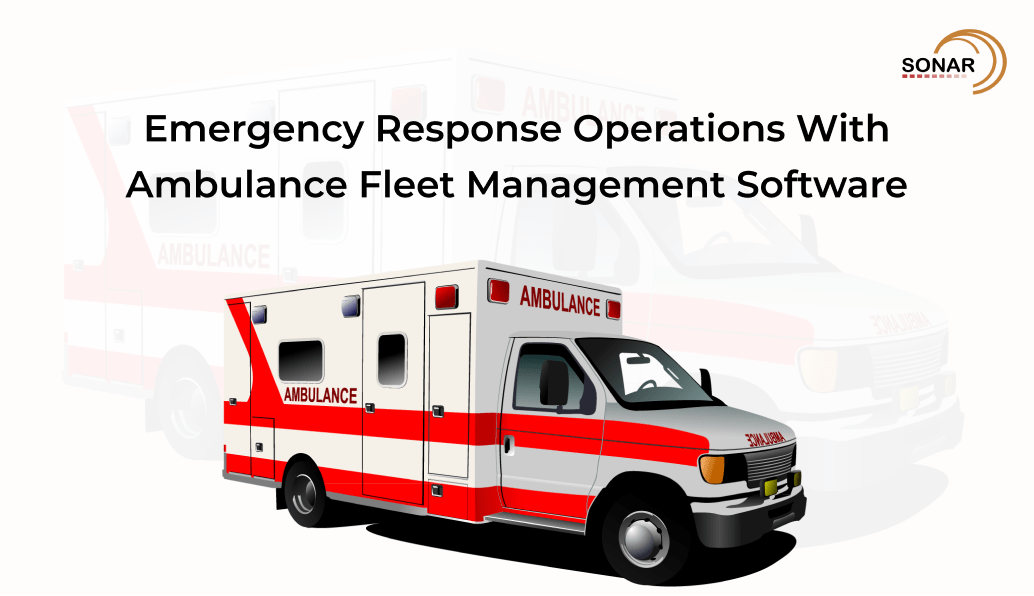Why is ambulance fleet management software important?
When someone calls an ambulance for an emergency, every second counts. EMS (Emergency Medical Services) organisations across the country use fleet ambulance tracking software for better response times and fleet management performance. Ambulances are perhaps one of the most important vehicles that people rely on in times of emergency.
The most useful feature of ambulance fleet management software is GPS tracking. Many ambulances around the world have chosen to modernise their vehicles. The most effective shipment of the correct ambulances guarantees prompt emergency medical services and timely patient transport.
Nowadays, ambulance tracking software must be quick to respond. They must be prepared to respond to emergencies at the drop of a hat. That patient must obtain the assistance they require. Otherwise, it could endanger the patient’s life. And anything you can do to shorten ambulance response time adds another minute or second.
Many paramedics and managers already use GPS trackers on their ambulances. Ambulance fleet management software tracking improves response time because dispatchers can locate the nearest ambulance to the patient in need. EMS providers have contracted to serve their communities in the best way possible, which includes responding swiftly and effectively. GPS ambulance tracking software makes this possible.
Since GPS tracking device are already an important part of many ambulances, there’s no need to waste space attempting to persuade you to use it. However, GPS tracking isn’t the only type of fleet management system that EMS companies require.
Another type of management is to keep ambulances up-to-date and serviced. In addition to GPS tracking, your ambulance supplier and manager must use many kinds of fleet management, which includes ambulance tracking software.
Medical Supplies
Medical supplies are the core elements of any ambulance’s assets. These items are used by first responders to treat patients and help them stabilise in stressful situations. Without them, your EMTs will be unable to assist people or do their duties.
As part of your fleet management system, you must discover a way to have each vehicle track its medical supplies. First responders may do this using cloud-based ambulance fleet management software by Sonar Technologies. Our platform allows you to distribute kits or collections to each vehicle. It can also notify your supplier when an item runs low and needs to be replaced. That way, you won’t have to worry about running out of resources when treating patients.
Medical technology
Along with supplies, your EMTs carry medical technology such as heart monitors, IV bags, and communication devices that allow them to communicate with the hospital receiving the patient. The ambulance tracking software feature and other onboard programmers can help your staff with their work.
Ambulance technology, like everything else, requires regular upkeep. Regular checkups with a skilled IT provider, whether in-house or through another company, help your system continue to function properly. When rushing a patient to the emergency room, you can’t afford to have a system update or a delay.
Vehicle Operation
While your ambulance contains a variety of supplies, technologies, and other devices, it is also a vehicle with all the things attached. If the car does not work, the rest of the system will also fail.
Consider scheduling a mechanic to check your ambulances when they are not in use. Determine the least busy hours and rotate your vehicles to ensure you have insurance and the capacity to respond to patient calls.
Here are the top benefits of using ambulance fleet management software: Create better fleet maintenance strategies.
Ambulance fleet management software allows for the creation of timetables, ensuring that no emergency can go by without a working vehicle due to an unplanned failure. Automating vehicle maintenance processes also relieves management of the needless strain of manually tracking schedules based on employee reports. Keeping emergency response vehicles in good condition is a critical, but also monumental, task.
Maintain a safe and secure work environment.
Installing ambulance tracking software gives managers a good opportunity to address safe driving behaviour with their employees. Transparent conversations with drivers about their ability to track speed, aggressive braking, and acceleration are the first step in managing and coaching better behaviour to create a safe environment during emergencies. In the medical industry, where malpractice and compliance are always top issues, using ambulance fleet management software can help encourage safety measures, which is vital for protecting your patients.
Gives good data insights.
Fleet ambulance tracking software metrics make the best use of limited resources by providing exact utilisation data on miles travelled, engine hours, days used, trip count, and a variety of other variables. Integrate with navigation tools to obtain real-time weather and traffic data, allowing vehicles to be routed more effectively under changing conditions.
Increasing emergency service efficiency.
Vehicle monitoring allows you to observe where your vehicle is, saving you significant time. With telematics, EMTs (Emergency Medical Technicians) only need to check a digital screen to know which ambulance is available, allowing them to board cars faster and spend more time responding to residents in an emergency. Ambulance fleet management software decreases fuel waste, which is one of the most expensive costs for most fleets in any business.
Enhances billing accuracy.
Ambulance tracking software provides unlimited data history, such as mileage, time, and units provided, which is beneficial for billing patients and providing evidence of service. If a patient disputes an invoice, GPS companies can easily provide dates, hours, and addresses related to the service as confirmation that the billing is correct.
Take Away: Ambulance Fleet Management Software Importance and Advantages:
- Emergency Medical Services (EMS) depend mainly on GPS ambulance tracking software for effective response times and fleet management.
- It enables dispatchers to locate the nearest ambulance to the patient in need, resulting in a timely and effective response.
- Other fleet management system requirements include updating and servicing ambulances, maintaining medical supplies, and keeping vehicles operational.
- Regular reviews with professional IT specialists are required to ensure the correct working of ambulance fleet management software.
- It is advised to schedule a mechanic to inspect ambulances while they are not in use and rotate vehicles to ensure insurance and the capacity to react to patient calls.
- Improves ambulance tracking software: it enables the construction of timetables and automates vehicle maintenance activities.
- Boosts emergency service efficiency: vehicle tracking saves time and reduces fuel waste.
- Provides useful data insights: Fleet metrics provide exact utilisation statistics such as miles travelled, engine hours, days used, trip count, and other characteristics.
- Improves billing accuracy: Unlimited history data is useful for billing patients and providing evidence of service.

